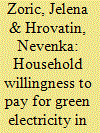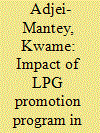|
|
|
Sort Order |
|
|
|
Items / Page
|
|
|
|
|
|
|
| Srl | Item |
| 1 |
ID:
110376


|
|
|
|
|
| Publication |
2011.
|
| Summary/Abstract |
The aim of this paper is to analyze consumers' awareness towards electric vehicle (EV) and examine the factors that are most likely to affect consumers' choice for EV in China. A comprehensive questionnaire survey has been conducted with 299 respondents from various driving schools in Nanjing. Three binary logistic regression models were used to determine the factors that contribute to consumers' acceptance of EVs, their purchase time and their purchase price. The results suggest that:
(1)
Whether a consumer chooses an EV is significantly influenced by the number of driver's licenses, number of vehicles, government policies and fuel price.
(2)
The timing of consumers' purchases of an EV is influenced by academic degree, annual income, number of vehicles, government policies, the opinion of peers and tax incentives.
(3)
The acceptance of purchase price of EVs is influenced by age, academic degree, number of family members, number of vehicles, the opinion of peers, maintenance cost and degree of safety.
These findings will help understand consumer's purchase behavior of EVs and have important policy implications related to the promotions of EVs in China.
|
|
|
|
|
|
|
|
|
|
|
|
|
|
|
|
| 2 |
ID:
177492


|
|
|
|
|
| Summary/Abstract |
The supply side of sustainable housing needs to be complemented with, driven by, and shaped around a willing and committed demand site. This study examines the sustainable housing sector of Pakistan by describing the potential buyers’ profile and quantifying their willingness to pay (WTP) for sustainable housing uptake in the market. WTP is estimated through a survey of 354 potential homebuyers. Furthermore, the hierarchical Bayesian model of adaptive choice-based conjoint analysis is utilized to study the correlation of descriptive determinants on WTP for sustainable housing. The results suggest that demographical factors of age, gender, and literacy level positively correlate with WTP whereas environmental knowledge and income level negatively correlate with WTP. Also, energy saving has the highest relative importance among other housing attributes. The study contributes a vital empirical input to the literature by finding the potential sustainable homebuyers in Pakistan and their characteristics and proposes several policy guidelines to promote the uptake of the sustainable housing sector in the country.
|
|
|
|
|
|
|
|
|
|
|
|
|
|
|
|
| 3 |
ID:
169841


|
|
|
|
|
| Summary/Abstract |
Renewable energy development in deregulated electricity markets dominated by fossil fuels has benefited from various government incentives and green marketing. Electricity generation in New Zealand is dominated by renewables and has developed with no government incentives or green marketing since the reforms in 1986. The New Zealand government has set a renewable energy target of 90% by 2025 with no direct support. The objective of this paper is to assess the potential for consumer-driven renewable energy development required to achieve this target by estimating willingness to pay for green electricity in the context of supplier choice. The study is based on a stated choice dataset generated using a choice experiment administered to an online panel of domestic electricity consumers in 2014. Results from a random parameter logit model estimated on 2688 choice responses show that, on average, consumers are willing to pay an extra $3.20 per month or 2% of their current power bills for a 10 percentage point increase in the share of electricity from renewable sources. These findings demonstrate that consumers are willing to support the development of renewables even where a market is dominated by renewables.
|
|
|
|
|
|
|
|
|
|
|
|
|
|
|
|
| 4 |
ID:
116760


|
|
|
|
|
| Publication |
2012.
|
| Summary/Abstract |
In this paper we estimate the willingness to pay for mix of renewable sources of electric power by means of a discrete choice experiment survey conducted in Spain in 2010. Two main categories of power supply attributes are explored: source of renewable power (wind, solar and biomass) and the origin of such power. The findings suggest that most consumers are not willing to pay a premium for increases in the shares of renewable in their electricity mix. For two of the three renewable sources considered (wind and biomass) an increase of the renewable mix would require a discount. Instead, we record positive willing to pay for increases in the share of both solar power and locally generated power. However, preferences for types of renewable (solar and wind) are found to be heterogeneous. By classifying respondents in two groups according to the implied importance of the share of renewable sources in their power mix we identify a market segment consisting of 20% of respondents that could promote renewable energy in the absence of subsidies. This is because such a segment shows willingness to pay higher than the current feed-in tariffs.
|
|
|
|
|
|
|
|
|
|
|
|
|
|
|
|
| 5 |
ID:
115692


|
|
|
|
|
| Publication |
2012.
|
| Summary/Abstract |
Carbon Capture and Storage (CCS) is an emerging technology to mitigate greenhouse gas emissions from fossil fuel-fired power plants. In the wake of a rapidly changing German energy system, CCS can play an important role. By means of an online survey among 130 university students in Dresden, this paper investigates the level and influencing factors of social acceptance of CCS. Furthermore, the individual willingness to pay for CCS and renewable power delivery is measured and compared through a choice model. The survey results reveal that the attitude towards CCS is neutral. Moreover, it is shown that acceptance of CCS is an important factor for the willingness to pay. The level of willingness to pay for CCS technology is much lower than for renewable energy.
|
|
|
|
|
|
|
|
|
|
|
|
|
|
|
|
| 6 |
ID:
143393


|
|
|
|
|
| Summary/Abstract |
A survey was conducted among 1489 consumers in seven pilot cities designated by the Chinese Ministry of Commerce for constructing a meat circulation traceability system.This study set four attributes for pork: traceability information, quality certification, appearance, and price. The preferences and willingness to pay (WTP) of consumers for traceability information, quality certification, appearance attributes, and influencing factors were investigated using choice experiments. According to results from both mixed logit and latent class models, quality certification was the most important characteristic, followed by appearance, and traceability information. “Government certification,” “very fresh-looking,” and “traceability information covering farming, slaughter and processing, circulation and marketing” were the most preferred levels of quality certification, appearance, and traceability information, respectively. Significant heterogeneity was observed in the consumer preferences for these attributes. The preferences and WTP of consumers for traceability information and quality certification were significantly influenced by age, monthly family income, and education level.
|
|
|
|
|
|
|
|
|
|
|
|
|
|
|
|
| 7 |
ID:
097437


|
|
|
|
|
| Publication |
2010.
|
| Summary/Abstract |
Modern forms of energy are an important vehicle towards poverty alleviation in rural areas of developing countries. Most developing countries' households rely heavily on wood fuel which impacts on their health and socio-economic status. To ease such a dependency, other modern forms of energy, namely electricity, need to be provided. However, the quality of the electricity service, namely reliability, is an important factor in reducing this dependency. This paper discusses a choice experiment valuation study conducted among electrified rural households located in Kisumu, Kenya, in which the willingness to pay (WTP) to avoid power outages or blackouts was estimated. A mixed logit estimation was applied to identify the various socio-economic and demographic characteristics which determine preferences in reducing power outages among a household's users. In conclusion, several of the socio-economic and demographic characteristics outlined in this paper were identified and can assist service differentiation to accommodate the diverse households' preferences towards the improvement of the electricity service.
|
|
|
|
|
|
|
|
|
|
|
|
|
|
|
|
| 8 |
ID:
111376


|
|
|
|
|
| Publication |
2012.
|
| Summary/Abstract |
This article examines consumer willingness to pay for energy-saving compact fluorescent light bulbs using the results of a stated preferences study conducted in the Caribbean island nation of Saint Lucia. Geographic location, low income status, and age are found to affect willingness-to-pay for compact fluorescent lighting, while higher income status and other demographic variables appear to have minimal or no significant impacts. Energy efficiency knowledge is associated with increased willingness-to-pay for energy-efficient bulbs and with increased use of compact fluorescent lighting. Contrary to theoretical expectations, past purchase of compact fluorescent bulbs is found to have no impact on self-reported willingness to pay. We hypothesize that this null result is due to the recent emergence of low-cost, low-quality compact fluorescent bulbs in the Saint Lucian lighting market, which may be negatively influencing consumers' preferences and expectations regarding energy-efficient lighting. Findings support the argument that government-sponsored education and subsidy programs will likely result in increased use of energy-saving technologies in Saint Lucia. But such behavioral changes may not be sustained in the long run unless low quality bulbs - the "lemons" of the compact fluorescent lighting market - can be clearly identified by consumers.
|
|
|
|
|
|
|
|
|
|
|
|
|
|
|
|
| 9 |
ID:
144516


|
|
|
|
|
| Summary/Abstract |
Using choice experiments, we estimate the willingness to pay for price insurance among cotton and paddy farmers in the Indian state of Gujarat. We also identify the interactions between the demand for price insurance and existing informal and formal risk management mechanisms. Our results indicate that cotton farmers value price insurance more than paddy farmers. Also, most of the existing informal risk management strategies seem to have a positive effect on the demand for price insurance, suggesting potential complementarities. Important policy implications on the design and bundling of innovative financial products follow from our findings.
|
|
|
|
|
|
|
|
|
|
|
|
|
|
|
|
| 10 |
ID:
125540


|
|
|
|
|
| Publication |
2013.
|
| Summary/Abstract |
As part of the move toward renewable energy sources in Germany it is expected that an increasing number of residential households will be equipped with communication-capable electricity metering systems (="smart meters" [SM]). SM cause considerable investment and operating expenses. For providers of such systems one avenue to recoup SM costs is to explicitly invoice various SM price components to end customers. The feasibility of this strategy heavily depends on residential electricity customers' willingness to pay (WTP) for SM and, furthermore, an understanding of factors that have an impact on WTP. Therefore, the present article develops hypotheses on associations between three perceived SM benefit facets, one perceived intangible SM cost type as well as environmental awareness in general on the one hand, and WTP for SM on the other. The hypotheses are tested in a sample of 453 German-speaking residential electricity customers who filled in an online questionnaire. PLS analysis of the survey data reveals that trust in the protection of personal SM data and the intention to change one's electricity consumption behaviors after SM deployment are the constructs most strongly related to WTP for SM. Expectations regarding SM-triggered electricity volume saving and environmental awareness contributed less toward explaining WTP. Overall, the considered WTP antecedents left 72% of the criterion variance unaccounted for. Implications of the findings are discussed for electricity suppliers planning large-scale SM deployments and future research in the field of energy policy.
|
|
|
|
|
|
|
|
|
|
|
|
|
|
|
|
| 11 |
ID:
103420


|
|
|
|
|
| Publication |
2011.
|
| Summary/Abstract |
This study presents empirical insight into willingness to pay (WTP) for microgeneration technologies and the relative influence of subjective consumer perceptions. First, we apply a double-bounded contingent valuation method to elicit Irish home owners' WTP for micro wind turbines, wood pellet boilers, solar panels and solar water heaters. Utilizing findings from the adoption of innovation literature, in a second step we assess the influence of antecedents on WTP for each of the four technologies, including (1) home owners' perception of product characteristics, (2) normative influences and (3) sociodemographic characteristics. Our results show that WTP varies significantly among the four technologies. More importantly, however, home owners hold different beliefs about the respective technologies, which significantly influence their WTP. The results provide valuable information for marketers and policy makers aiming to promote microgeneration technologies more effectively in consumer markets.
|
|
|
|
|
|
|
|
|
|
|
|
|
|
|
|
| 12 |
ID:
192724


|
|
|
|
|
| Summary/Abstract |
Reliable electricity is a key factor in improving the living conditions of households and sustainable development of countries. Developing country governments and international organizations address the question of how to obtain a reliable supply of electricity and thus eliminate power outages at the top of their political agendas. In this framework, the aim of this paper is to estimate the willingness to pay of Indian urban consumers for having a continuous supply of electricity, avoiding unexpected power outages, using contingent valuation method. Two different econometric approaches are used. The households in the survey have been asked to state their willingness to pay for five different types of outages. Empirical data from 1043 Indian households has been analyzed using double hurdle approach. The econometric results indicate that, among the investigated households with an average individual annual income around $1630,00, their willingness to pay to avoid power outage strictly depend on the length of outages ranging, on average, from $0.37 (2 h) $3.00 (12 h), that is, households prefer to reduce the duration of outages. Further, income and environmental attitude of respondents positively influence higher WTP to avoid power outages. Our findings provide useful insights for policy makers to design and promote more reliable and customer centric energy generation and distribution models.
|
|
|
|
|
|
|
|
|
|
|
|
|
|
|
|
| 13 |
ID:
132790


|
|
|
|
|
| Publication |
2014.
|
| Summary/Abstract |
This paper explores people×s preferences for a Built in Photovoltaic (BIPV) renewable energy system to be integrated into housing construction. A novel methodology was developed, to study the case of Northern Cyprus, for better understanding of possibilities that abound in BIPV integration. The methodology incorporates Building Information Modeling (BIM) as a real-time design and economic assessment tool for BIPV choices. This serves to benefit both the construction companies and potential house owners in their decision-making. In addition, it uses a Contingent Valuation (CV) method to assess the Willingness to Pay (WTP) and the Willingness to Accept (WTA) compensation. The results indicate that the capital cost of PV is not instrumental in choice, and a lower feed-in tariff could be acceptable.
|
|
|
|
|
|
|
|
|
|
|
|
|
|
|
|
| 14 |
ID:
186473


|
|
|
|
|
| Summary/Abstract |
The development of Renewable Energies (RE) must be stepped up in the coming years if we are to successfully realise the ambitious energy transition challenge set by many governments across the globe. However, the energy transition is far from obvious, especially with regard to the social acceptability of RE. In this context, we used a Discrete Choice Experiment combined with a Geographical Information System to assess the willingness of individuals to switch to a more virtuous energy mix based on three energy sources (wind, photovoltaic and biogas). Our results show a dominant generational effect, indicating that young people are more likely to accept renewable energy in their neighborhoods. Furthermore, residents in areas with renewable energy with negative externalities (wind turbines and anaerobic digestion units) tend to have a lower Willingness to Pay than residents in other areas, which is what we call the principle of territorial distributive justice. There is no reason to believe that the difficulties in finding new locations for RE installations could fade away. Therefore, an increased effort of public policies to plan the location of future RE facilities in a more equitable way and always a better explanation and co-construction of new RE projects are needed.
|
|
|
|
|
|
|
|
|
|
|
|
|
|
|
|
| 15 |
ID:
114302


|
|
|
|
|
| Publication |
2012.
|
| Summary/Abstract |
This paper analyses the willingness to pay for electricity generated from renewable energy sources in Slovenia. The results confirm that age, household income, education and environmental awareness play the most important role in explaining household attitudes to green electricity programmes. While the willingness to participate in green electricity programmes is influenced by education and environmental awareness, the willingness to pay for green electricity predominantly depends on household income. The results imply that green marketing should be accompanied by awareness-raising campaigns and should target younger, well-educated and high-income households. The expressed median willingness to pay is found to exceed the current level of mandatory charges for green electricity. Nevertheless, recent increases in final electricity prices might have already exhausted the capacity for additional voluntary contributions.
|
|
|
|
|
|
|
|
|
|
|
|
|
|
|
|
| 16 |
ID:
104923


|
|
|
|
|
| Publication |
2011.
|
| Summary/Abstract |
Underground low-voltage electricity networks have several advantages over overhead networks including reliability of supply, safety and improved visual amenity. The economic viability of replacing existing overhead networks with new underground networks depends on the value of these benefits to households, but no complete value estimates are available in the literature. This paper represents a contribution towards addressing this research gap. A stated choice survey is used to estimate willingness to pay for undergrounding in established residential areas in Canberra, Australia. Average willingness to pay is at least A$6838 per household and there is significant variation in preferences over the population. The results suggest that benefits would be highest in areas with higher household income and older residents where visual amenity, safety, tree trimming, or restrictions on the use of yard space are of concern.
|
|
|
|
|
|
|
|
|
|
|
|
|
|
|
|
| 17 |
ID:
176730


|
|
|
|
|
| Summary/Abstract |
Energy utilization of crop straw is of high economic, social and ecological benefit. In this paper, based on the beneficiary pays principle, we use biogas production from crop straw as an example and analyze households' willingness to pay (WTP) for the local government-led project on energy utilization of crop straw. “Interpersonal trust” and “institutional trust” variables are introduced to improve the unified theory of acceptance and use of technology (UTAUT) model, on the basis of which, Probit and Interval Regression Models are employed to explore the determinants of households' WTP. Results show that: 1) Most households are willing to pay for biogas utilization of crop straw, and the average expected value of households' WTP is about 20.72 RMB per household monthly; 2) Crop straw program cost and benefit trade-offs, convenience of logistics and technology, and trust factors all play an important role in households’ WTP; 3) If the cultivation of trust is neglected, even if households have high expectations for the ecological performance of biogas production from crop straw, their WTP will not be improved. Conclusions are summarized to provide an important reference for the formulation of policies to improve energy utilization of crop straw in developing countries or regions.
|
|
|
|
|
|
|
|
|
|
|
|
|
|
|
|
| 18 |
ID:
177309


|
|
|
|
|
| Summary/Abstract |
Although Nigeria is endowed with plenty of sustainable energy resources, most rural households still rely heavily on conventional energy. Nigerians want to transition to clean energy but cannot afford the upfront costs. Households have long waited for the government to solve energy problems, to no avail. Rural households’ welfare can be improved if investors adopt an installment plan. However, businesses are concerned about economic gains. Thus, it is vital to investigate how much money rural households can afford every month, how long it would take them to complete the payment, and whether it is feasible for investors. In light of this, this study employs the contingent valuation method (CVM) to elicit responses and estimate the willingness to pay (WTP) for a pico-photovoltaic (pico-PV) system and improved cookstove (ICS). The results show that rural households have strong preferences for sustainable energy. Energy transition would save each household $60 annually. Furthermore, the cost-benefit analysis shows that it is viable to invest in the business. Thus, policymakers need to focus on attracting investors to rural areas, providing a conducive environment, and helping businesses keep track of people who sign up for the program.
|
|
|
|
|
|
|
|
|
|
|
|
|
|
|
|
| 19 |
ID:
181778


|
|
|
|
|
| Summary/Abstract |
Many countries, states, and territories have set short and long term targets to increase the share of renewable sources for electricity generation as part of their respective energy policies. Increased reliance on renewables can occur from several sources (e.g., biomass, solar, hydro, wind). Similarly, when increasing renewables, a decreased reliance on one or more non-renewable (e.g., coal, gas, oil, nuclear) sources must occur. However, each region is different with respect to its present profile and capabilities to generate electricity. Complicating this is that demand can differ across individuals, states and territories. By using a discrete choice experiment and latent class hybrid choice model (LCHCM), we estimate individual willingness to pay (WTP) values among four renewable and four non-renewable energy sources for residents across Australia’s states and territories. The model identifies two latent segments in relation to WTP, which can be described using differences in pro-environmental attitudes and socio-demographics. The findings reveal that preferences in terms of energy mix composition for electricity generation are heterogeneous across Australia states and individuals. WTP is found to be higher for biomass, whilst those who are younger, males and those holding pro-environmental attitudes are also supportive of hydro and solar over gas and nuclear sources.
|
|
|
|
|
|
|
|
|
|
|
|
|
|
|
|
| 20 |
ID:
181468


|
|
|
|
|
| Summary/Abstract |
This study investigates the impact of a clean cooking intervention on primary fuel choice and on households’ willingness to pay for an improved LPG distribution model in Ghana. Using data obtained via a survey of 904 households in two beneficiary districts, we found that the intervention led to higher LPG usage. The program increases the probability of households choosing LPG as a primary cooking fuel by 24% and the rate of use of LPG among households by 33%. Furthermore, an analysis of willingness to pay shows that delivery preference is not statistically different between beneficiary and control groups. The distance to refill the cylinder significantly affects LPG usage and willingness to pay. A policy that brings LPG refill closer to households and reduces the time and money cost of accessing a refill station is key to increasing the adoption of LPG as the primary cooking fuel.
|
|
|
|
|
|
|
|
|
|
|
|
|
|
|
|
|
|
|
|
|